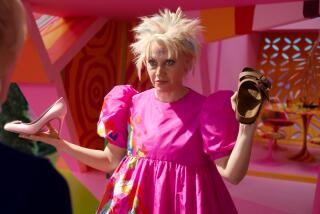China’s Kids Have New, More Familiar Face to Play With
- Share via
SHANGHAI — Barbie has a new rival. She’s beautiful, and she was born in Shanghai.
The Yue-Sai doll is the brainchild of cosmetics queen and TV personality Yue-Sai Kan. The Chinese American, who has a home in Shanghai, is a household name here for her line of makeup designed for the Chinese complexion. She moved into the toy business this year after discovering that practically all the dolls sold in the country have Western features.
Her dream was to create the first designer doll that could challenge the Asian infatuation with Western beauty standards.
But Chinese-looking dolls have never been popular here. Most store shelves display rubber babies with round, cuddly bodies, blinking blue eyes and curly blond hair. The few available folk dolls in ethnic minority costumes are usually poorly made wooden stick figures.
Dolls with movable body parts and interchangeable costumes are still a relatively novel concept here. So even though Kan’s mini-temptress has black hair and Chinese dresses, the locals still see it very much as a Chinese version of Barbie.
Kan said she is used to that kind of comparison. When she was a television host they called her the Barbara Walters of China. When she began selling cosmetics they called her the Estee Lauder of China.
People need to see trendsetters through a familiar lens, she said. Nonetheless, she doesn’t see her product as a copycat.
“I don’t believe an Asian doll has to be plump and fat,” Kan said. “She should be as fashionable as anyone in the world.”
Like its creator, the doll, or wawa in Chinese, is very much a cosmopolitan gal with an East-meets-West aesthetic. While she has Barbie’s long legs and ballroom gowns, she also has Kan’s relatively flat face and fine taste for silk qipaos, a slim-fitting Chinese dress with high collars.
At the Huai Hai Children Articles store on the bustling Huai Hai Road in Shanghai, where the doll has been on sale since early this month, the bestsellers have been a flamenco-dancing wawa in red-and-black ruffles that is called Yue-Sai in Spain. Another is the Winter Princess, a Snow White-like wawa in green and red.
Less popular are the wawas in pink-and-lime Chinese dresses. But they are hot with foreigners, who snatch them up as souvenirs.
Sun Weiyi, 29, bought the Winter Princess as a gift because she wanted a chic toy that was not a Barbie. But she had expected to find the Yue-Sai wawa to be even more Asian looking.
“Maybe it would have single eyelids and shorter lashes,” Sun said.
But salesclerk Chen Shuwen, 19, said that if the doll really had smaller eyes, customers would flee.
Down by the competitor’s counter, a Barbie saleswoman said it’s natural for the Chinese to gravitate to foreign dolls. “I see Chinese faces every day. There is no need to buy a doll that looks the same,” she said.
But with a price tag of about $12 to $350--slightly less than the range for Barbies--Kan’s delicate playthings remain too expensive for most Chinese families. China has 380 million children, a figure about 40% higher than the entire U.S. population. But the Asian country remains predominantly an exporter of toys.
Domestically, the average spending per child on toys is about $4 a year. In contrast, the American family on average forks out about $300 per child in toy spending, according to Xu Quanning of the Shanghai Toy Assn.
The largest potential domestic toy market is China’s poorer hinterlands. But the per capita spending there is only about $1 a child each year, so it’s hard to imagine that buyers would be too picky about the toy’s ethnic identity. “As long as it looks like a person, they would be happy,” Xu said.
But toy makers, like auto or computer manufacturers, are banking on the country’s growing middle class to develop a taste for the finer things of consumer culture--people like 23-year-old Li Yuxi, a secretary at General Electric’s office in Shanghai, who grew up with little to play with and is now stocking up on things she couldn’t have as a child.
“My first doll was a boy with no clothes and gray paint for hair,” said Li, who has surrounded her apartment with outsize stuffed animals and soft wawas that also function as cushions and pillows. She’s looking forward to checking out the new doll.
As the wawa’s mother, Kan said, that’s all she is asking for.
“Asia is not a small place. Yet there is not a single representative Asian doll,” Kan said. “That’s not fair to the children. If nothing else, the kids should have a choice.”
More to Read
Sign up for Essential California
The most important California stories and recommendations in your inbox every morning.
You may occasionally receive promotional content from the Los Angeles Times.













